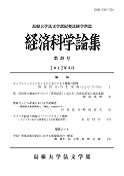島根大学法文学部
ISSN:0387-7310

ダウンロード数 : ? 件
この文献の参照には次のURLをご利用ください : https://ir.lib.shimane-u.ac.jp/2172
経済科学論集 25
1999-03-31 発行
1970-90年における女子の未婚率上昇の要因分解
A Decomposition of Increase in Proportion Never-married for Women in Japan from 1970 to 1990
廣嶋 清志
ファイル
内容記述(抄録等)
Being never-married has been prevailing among younger generations in Japan. Over the twenty years from 1970 to 1990, the proportion never-married of Japanese women aged 20-24 and 25-29 increased by 13.5 and 21.6 percent point respectively according to the population census result. We tried to decompose these remarkable increases by compositional changes, i.e. those in educational level or working status of women and percentage increases never-married by the educational level or working status.
We found that two thirds of the percentage increase never-married for women aged 20-24 was accounted for by the compositional change in educational attainment level, i.e. rising enrollment in higher education. In contrast to this, more than seventy percent of the rise in the proportion never-married of the females aged 25-29 was accounted for by the rise in the proportion never-married by educational level. In the same manner, only small portion of the rise in the proportion never-marrie,d of women aged 20 - 24 and 25-29 was accounted for by the rising share of working women and most of that was accounted for by increasing proportion never-married by working status of women. Even if we further decompose this and include the distribution change of occupation of women in compositional effect, only less than half (age 25-29) or a quarter (age 20-24) of the increasing proportion never-married was accounted for.
In sum, factors that seem most influential such as changes in working status including occupational distribution and educational level do not have a decisive role in explaining the expansion of never-married status. This means the process is universal throughout any social strata in Japan. The process can be one of those involved in the changes in social relations from institution-based into individual-based and the rising status of women. In this sense, the process may have a common nature with the so-called second demographic transition in Europe.
We found that two thirds of the percentage increase never-married for women aged 20-24 was accounted for by the compositional change in educational attainment level, i.e. rising enrollment in higher education. In contrast to this, more than seventy percent of the rise in the proportion never-married of the females aged 25-29 was accounted for by the rise in the proportion never-married by educational level. In the same manner, only small portion of the rise in the proportion never-marrie,d of women aged 20 - 24 and 25-29 was accounted for by the rising share of working women and most of that was accounted for by increasing proportion never-married by working status of women. Even if we further decompose this and include the distribution change of occupation of women in compositional effect, only less than half (age 25-29) or a quarter (age 20-24) of the increasing proportion never-married was accounted for.
In sum, factors that seem most influential such as changes in working status including occupational distribution and educational level do not have a decisive role in explaining the expansion of never-married status. This means the process is universal throughout any social strata in Japan. The process can be one of those involved in the changes in social relations from institution-based into individual-based and the rising status of women. In this sense, the process may have a common nature with the so-called second demographic transition in Europe.
Other Article
